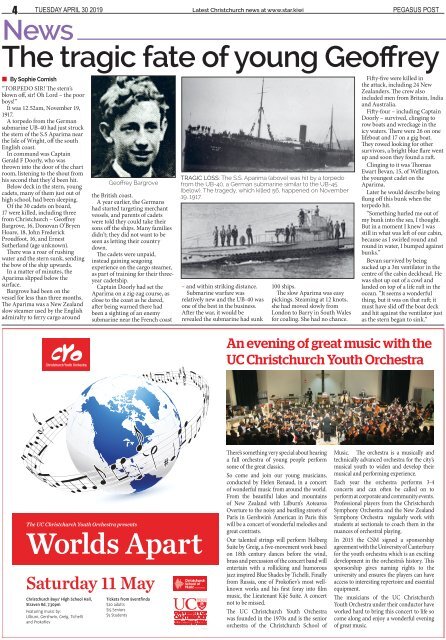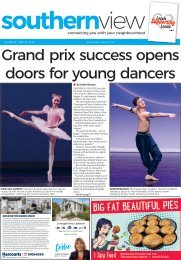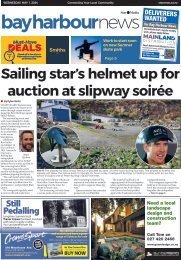Create successful ePaper yourself
Turn your PDF publications into a flip-book with our unique Google optimized e-Paper software.
4 Tuesday <strong>April</strong> <strong>30</strong> <strong>2019</strong><br />
Latest Christchurch news at www.star.kiwi<br />
News<br />
PEGASUS POST<br />
The tragic fate of young Geoffrey<br />
• By Sophie Cornish<br />
“TORPEDO SIR! The stern’s<br />
blown off, sir! Oh Lord – the poor<br />
boys!”<br />
It was 12.52am, November 19,<br />
1917.<br />
A torpedo from the German<br />
submarine UB-40 had just struck<br />
the stern of the S.S Aparima near<br />
the Isle of Wright, off the south<br />
English coast.<br />
In command was Captain<br />
Gerald F Doorly, who was<br />
thrown into the door of the chart<br />
room, listening to the shout from<br />
his second that they’d been hit.<br />
Below deck in the stern, young<br />
cadets, many of them just out of<br />
high school, had been sleeping.<br />
Of the <strong>30</strong> cadets on board,<br />
17 were killed, including three<br />
from Christchurch – Geoffrey<br />
Bargrove, 16, Donovan O’Bryen<br />
Hoare, 18, John Frederick<br />
Proudfoot, 16, and Ernest<br />
Sutherland (age unknown).<br />
There was a roar of rushing<br />
water and the stern sunk, sending<br />
the bow of the ship upwards.<br />
In a matter of minutes, the<br />
Aparima slipped below the<br />
surface.<br />
Bargrove had been on the<br />
vessel for less than three months.<br />
The Aparima was a New Zealand<br />
slow steamer used by the English<br />
admiralty to ferry cargo around<br />
Geoffrey Bargrove<br />
the British coast.<br />
A year earlier, the Germans<br />
had started targeting merchant<br />
vessels, and parents of cadets<br />
were told they could take their<br />
sons off the ships. Many families<br />
didn’t; they did not want to be<br />
seen as letting their country<br />
down.<br />
The cadets were unpaid,<br />
instead gaining seagoing<br />
experience on the cargo steamer,<br />
as part of training for their threeyear<br />
cadetship.<br />
Captain Doorly had set the<br />
Aparima on a zig-zag course, as<br />
close to the coast as he dared,<br />
after being warned there had<br />
been a sighting of an enemy<br />
submarine near the French coast<br />
TRAGIC LOSS: The S.S. Aparima (above) was hit by a torpedo<br />
from the UB-40, a German submarine similar to the UB-45<br />
(below). The tragedy, which killed 56, happened on November<br />
19, 1917.<br />
– and within striking distance.<br />
Submarine warfare was<br />
relatively new and the UB-40 was<br />
one of the best in the business.<br />
After the war, it would be<br />
revealed the submarine had sunk<br />
100 ships.<br />
The slow Aparima was easy<br />
pickings. Steaming at 12 knots,<br />
she had moved slowly from<br />
London to Barry in South Wales<br />
for coaling. She had no chance.<br />
Fifty-five were killed in<br />
the attack, including 24 New<br />
Zealanders. The crew also<br />
included men from Britain, India<br />
and Australia.<br />
Fifty-four – including Captain<br />
Doorly – survived, clinging to<br />
row boats and wreckage in the<br />
icy waters. There were 26 on one<br />
lifeboat and 17 on a gig boat.<br />
They rowed looking for other<br />
survivors, a bright blue flare went<br />
up and soon they found a raft.<br />
Clinging to it was Thomas<br />
Ewart Bevan, 15, of Wellington,<br />
the youngest cadet on the<br />
Aparima.<br />
Later he would describe being<br />
flung off this bunk when the<br />
torpedo hit.<br />
“Something hurled me out of<br />
my bunk into the sea, I thought.<br />
But in a moment I knew I was<br />
still in what was left of our cabin,<br />
because as I swirled round and<br />
round in water, I bumped against<br />
bunks.”<br />
Bevan survived by being<br />
sucked up a 3m ventilator in the<br />
centre of the cabin deckhead. He<br />
was shot up out of a cowl and<br />
landed on top of a life raft in the<br />
ocean. “It seems a wonderful<br />
thing, but it was on that raft; it<br />
must have slid off the boat deck<br />
and hit against the ventilator just<br />
as the stern began to sink.”<br />
An evening of great music with the<br />
UC Christchurch Youth Orchestra<br />
The UC Christchurch Youth Orchestra presents<br />
Worlds Apart<br />
Saturday 11 May<br />
Christchurch Boys’ High School Hall,<br />
Straven Rd, 7.<strong>30</strong>pm<br />
Featuring music by:<br />
Lilburn, Gershwin, Greig, Tichelli<br />
and Prokofiev<br />
Tickets from Eventfinda<br />
$20 adults<br />
$15 Seniors<br />
$5 Students<br />
ARTC83<strong>30</strong><br />
There’s something very special about hearing<br />
a full orchestra of young people perform<br />
some of the great classics.<br />
So come and join our young musicians,<br />
conducted by Helen Renaud, in a concert<br />
of wonderful music from around the world.<br />
From the beautiful lakes and mountains<br />
of New Zealand with Lilburn’s Aotearoa<br />
Overture to the noisy and bustling streets of<br />
Paris in Gershwin’s American in Paris this<br />
will be a concert of wonderful melodies and<br />
great contrasts.<br />
Our talented strings will perform Holberg<br />
Suite by Greig, a five-movement work based<br />
on 18th century dances before the wind,<br />
brass and percussion of the concert band will<br />
entertain with a rollicking and humorous<br />
jazz inspired Blue Shades by Tichelli. Finally<br />
from Russia, one of Prokofiev’s most wellknown<br />
works and his first foray into film<br />
music, the Lieutenant Kijé Suite. A concert<br />
not to be missed.<br />
The UC Christchurch Youth Orchestra<br />
was founded in the 1970s and is the senior<br />
orchestra of the Christchurch School of<br />
Music. The orchestra is a musically and<br />
technically advanced orchestra for the city’s<br />
musical youth to widen and develop their<br />
musical and performing experience.<br />
Each year the orchestra performs 3-4<br />
concerts and can often be called on to<br />
perform at corporate and community events.<br />
Professional players from the Christchurch<br />
Symphony Orchestra and the New Zealand<br />
Symphony Orchestra regularly work with<br />
students at sectionals to coach them in the<br />
nuances of orchestral playing.<br />
In 2015 the CSM signed a sponsorship<br />
agreement with the University of Canterbury<br />
for the youth orchestra which is an exciting<br />
development in the orchestra’s history. This<br />
sponsorship gives naming rights to the<br />
university and ensures the players can have<br />
access to interesting repertoire and essential<br />
equipment.<br />
The musicians of the UC Christchurch<br />
Youth Orchestra under their conductor have<br />
worked hard to bring this concert to life so<br />
come along and enjoy a wonderful evening<br />
of great music.


















